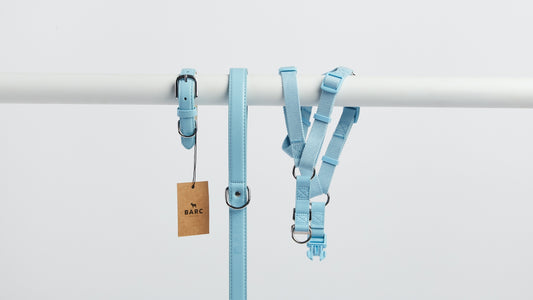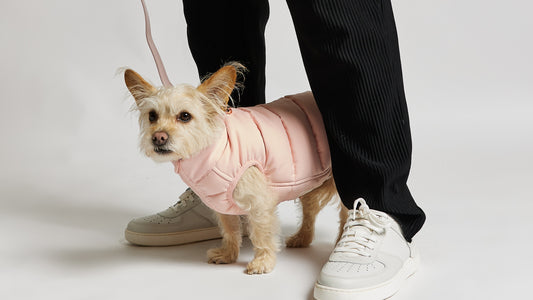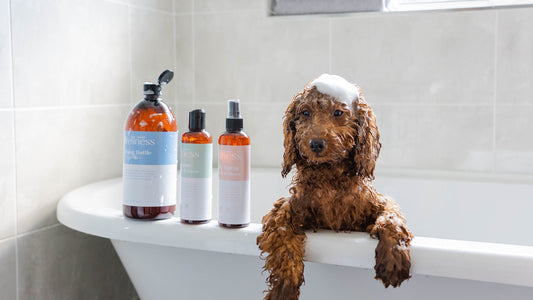If there’s one thing that’s for sure, dogs will always need to go out on walks.
So, a good starting point as a new dog owner can be to ensure that you’re geared up for daily walks from the get-go.
If you’re struggling to decide between collars and harnesses for dogs, don’t worry - you're not alone!
We’ve created this guide to cover everything you need to know about shopping for dog harnesses to help you find the perfect lead attachment for your pup.
Dog Harness Guide:
- What is the purpose of a dog harness?
- How does a dog harness work?
- What are the different types of harnesses for dogs?
- How does a harness work for dogs?
- What are the benefits of using a dog harness?
- Is it easier to control a dog with a harness or a collar?
- Are dog harnesses safe for puppies?
- What is the best dog harness for pulling?
At the bottom of this guide we have included helpful information for measuring and fitting your dog for a harness.

Photo: Dachshund wears Ivory City Dog Harness
Source: @sausagedoug_ via Instagram
What is the purpose of a dog harness?
The purpose of a dog harness is to guide dogs during walks, and provide them with an option that reduces tension on the neck when they pull.
Dog harnesses are made of straps that wrap around a dog's torso, and similar to a dog collar, they feature clips and D-Rings which get attached to the lead.
There are lots of different types of dog harnesses available, each with their own purpose and benefits.
On the whole, dog harnesses are helpful training tools for lead walking as they allow for greater control.
How does a dog harness work?
A dog harness works by utilising a dog’s pulling power and allowing for more control during dog walks.
By distributing weight, harnesses reduce pressure on dogs’ collars and necks to the shoulders, chest and back area.
Because of this, dog harnesses help to provide greater comfort and reduce risks like neck strain and choking.

Photo: French Bulldog wears Liquorice Stripe Dog Harness
Source: @roothepotato_frenchie via Instagram
What are the main types of harnesses for dogs?
There are four main types of dog harnesses that can be used for walks and lead training. The different types include:
- Back clip harnesses
- Front clip harnesses
- Dual clip harnesses
- Step in harnesses
Though similar, each of these dog harnesses has their own pros and cons, and you’ll need to work out which type is best suited to your dog’s breed, size and temperament during walks.


Types of dog harnesses:
Back Clip Harnesses
Back clip harnesses are the most common harness that you’ll find when shopping around, and these are the type of dog harnesses that we currently sell.
With a similar design to the front clip harness, back clip harnesses feature D-rings that are positioned in the centre of a dog's back.
Back clip harnesses are by far the simplest and easiest harnesses to use, and can be used with a variety of dog leads, including retractable ones.
We recommend these harnesses for dogs that tend to be quite calm on dog walks, as they are less effective at discouraging pulling.
Y-Shaped Harnesses
Our latest range of back-clip dog harnesses feature a Y-Shaped front design.
Upgraded from our core collection, these harnesses provide greater freedom of shoulder movement during walks.
With improved fit and back clip fastening, each harness helps to distribute a dog's weight and alleviate neck pressure during walks.

Photo: Shih-Poo wears Green City Dog Harness
Source: @merle.bros via Instagram
Front Clip Harnesses
Commonly referred to as ‘anti-pull harnesses’, front clip harnesses feature D-rings for the leash attachment that are positioned on a dog’s chest (as opposed to the back).
Front clip harnesses change the point of leverage, so they are best suited to dogs that pull on the lead during walks.
They are helpful for training purposes, as when a dog pulls, the leash moves to the side and shortens, guiding the dog back towards their owner.
Dual Clip Harnesses
Dual clip harnesses allow leads to be attached to a back-clip or a front-clip.
Because of this, they are a versatile option that can be used in two ways - on everyday dog walks and when walking through areas where greater control is needed.
These harnesses are also helpful in preventing injury as the pressure is distributed evenly across a dog’s body.
However, be advised that these types of harnesses can take a while to get used to, they tend to be a bulkier option that should be kept for training purposes.
Step In Dog Harnesses
With a step-in harness, a dog steps into the straps with both front paws, and then the harness is fastened at the back.
Some dogs dislike having harnesses put over their heads, so in this instance, a step in harness is the ideal solution.

Photo: Cavalier King Charles Spaniel wears Liquorice Stripe Dog Harness
Source: @goodboyoskar via Instagram



